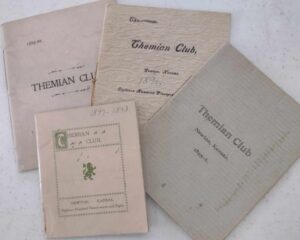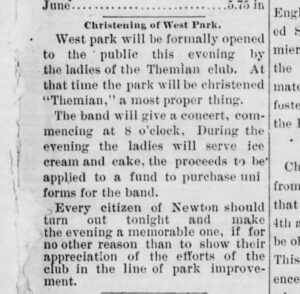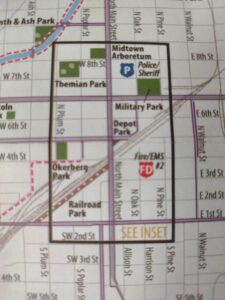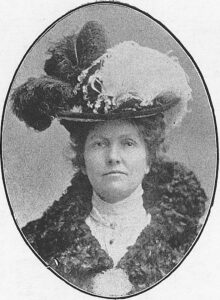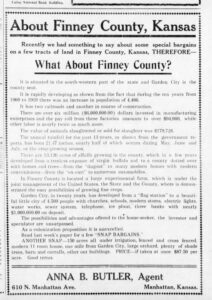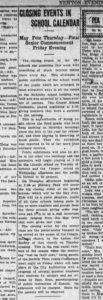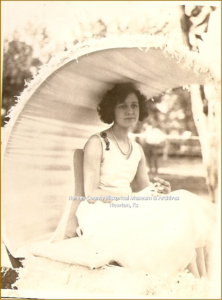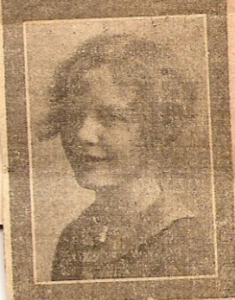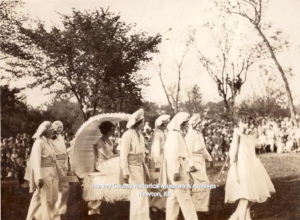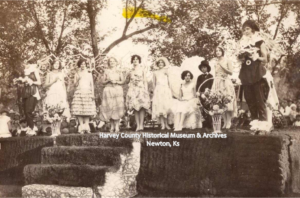by Kristine Schmucker, Archivist/Curator
The First Woman’s Group in Town: Themian Club
The day was ideal, “autumn sun, soft and yellow and the late rain making the air fresh and invigorating.” The event meticulously planned and presented. It was a fine October morning in 1919, to celebrate the silver anniversary of the Themian Club, the oldest woman’s group in Newton. The celebration was held in the lovely home of Mrs. H.L. Hart, “just west of town.” Upon arriving the women found “four spacious rooms opening together, set with quartet tables and one long table, beautiful snowy linen, silver and crystal and basket vases of pink carnations and greenery – the club colors.” Present at the event were fifteen of seventeen of the past presidents of the club.
“The Club That Gets Things Done”
After a four-course dinner was served, the first president and charter member, Amelia C. (Mrs. S.R.) Peters, recalled the early years of the club.
“She remembered clearly about the earlier efforts of the woman suffrage society in Newton. How the sentiment grew after the war and the outgrowth was suffrage societies.”
In Kansas, after municipal suffrage was granted in 1887, these societies disbanded in Newton. In the absence of these societies, the women of Newton organized the Themian Club. Named after the Greek goddess of Divine Justice, Themis, they adopted for their motto a quote from Lincoln, “”do the best you can if not, the best possible.” Among their early accomplishments was the establishment of a curfew bell to ring at nine o’clock every evening. They had a keen interest in civic projects and became known as “the club that gets things done.” At one point the club had 150 members.
The Themian Club was the first woman’s club established in Newton and throughout the years they promoted projects of public interest and welfare. Some of the projects included the Public Library, the Music Talent Audition to support young musicians, Penny Art Fund and Gifts to the War Veterans of War 1 including the Cancer Control project of the Field Army. The Themian Club supports worthwhile causes both locally and nationally. (“History of the Themian Club,” von der Heiden)
Themian Park
One of the club’s biggest contributions to the Newton community was Themian Park. In 1875, two city parks were established one in Block 24 (West Park) at N Poplar & 7th, and in Block 30 (East Park) Broadway & Oak.
Over time the upkeep of the parks left something to be desired. The ladies of the Themian Club had a proposal for the City Council.
“The Question of Parks”
In the February 16, 1898 issue of the Evening Kansan Republican it was reported that the Themian Club and the Commercial Club met with the city council for the purpose of improving the city parks. The president of the Themian club, Mrs. S.R. Peters reported that the club “is ready to prosecute the work it commenced last summer. The park fund now has $109 to its credit . . .to be used in beautifying the parks.” If the city council and Commercial Club would match the funds “the two parks will indeed look metropolitan by next summer.” The ladies had already secured J.P. Rogers of Topeka to submit plans for the two parks when he submitted plans for Athletic Park.
July 1, 1898, the Themian Club held a formal opening of the refreshed West Park. Plans included musical entertainment with refreshments of ice cream and cake. The reporter noted that “the place presents a remarkably different appearance from that of last summer.”
For several years the actual upkeep of Themian Park was the responsibility of the club members. After several years, the city took over the upkeep of the park.
Later Mrs. Amelia Peters, Themian Club’s first president, would recall that the club,
“agitated the question of parks. Secured Themian Park and had it named for the club. Hired a landscape gardener and planted the park to trees and flowers. Later the city council took over the parks, not showing favor toward flower beds and women pottering around.” (Newton Journal, 17 October 1919)
The ladies of the Themian Club also worked on Military Plaza Park. However, in September 1898 they decided that it would “take a good sum to beautify the East park according to the plans, and the east siders are willing to wait till enough money can be raised to do the work properly. The club will . . . give its attention to maintaining Themian park.” (Evening Kansan Republican, 7 September 1898)
This fall, get out and enjoy the two oldest parks in Newton, Themian and Military Parks.
Newton City Parks Quick Facts
- April 1875 East (Block 30) and West Parks (Block 24) established.
- In 1898, the Commercial Club had the honor of renaming the park in Block 30 Military Park and a year later in May 1899, the Themian Club was asked to rename West Park. They decided on Themian Park.
- Military Park was also known as Military Plaza. The Themian Club worked on improving this park.
- Nov 2, 1909 Athletic Park vote carried to purchase 30-acre tract of land from the Newton Driving & Athletic Association.
Sources
- History of the Themian Club: 1894-1945 by Mrs. W.H. von der Heiden, Clubs & Organizations, Box 3A, Harvey County Historical Museum & Archives, Newton, Ks.
- Themian Club, Clubs & Organizations, Harvey County Historical Museum & Archives, Newton, Ks.
- “Three Beautiful Parks” 22 August 1922, 50th Anniversary Edition, Newton Kansan.
- Newton Journal 19 October 1919.
- Evening Kansan Republican: 30 July 1897, 1 February 1898, 8 April 1898, 15 June 1898, 1 July 1898, 7 September 1898, 21 March 1899, 4 May 1900.


